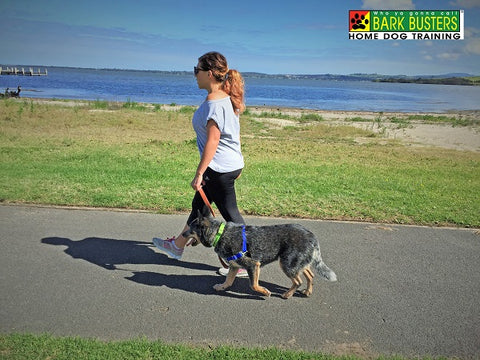The Right Dog Leash To Walk Your Dog

If you want your dog to walk correctly by your side, you need to make sure you have the right equipment. Bark Busters always recommends a 6-foot leash. Please do not use a retractable leash as this can cause injury to both yourself and the dog.
According to the Consumer Product Safety Association, there were 16,564 hospital-treated injuries associated with leashes. Approximately 23.6% involved injuries to the finger. Although all of these injuries are not attributable to retractable leashes, the following problems could occur:
- Most retractable leashes use a 26-foot chord. This distance could cause the animal to escape and run into the street. Additionally, should your dog be approached by an aggressive dog, it is harder to get control of the situation than if you are using a 6-foot leash.
- The cord can snap and cause cuts and burn.
- If the dog walker gets tangled in the cord (which is easy to do), bruises, broken bones and “road rash” can occur.
- A sudden jerk to the dog’s neck can cause spine injuries, lacerated tracheas and neck wounds to the dog.
- If you have not trained your dog to walk properly on a 6-foot leash, and are only using a retractable leash, you are teaching your dog to pull, making it harder to control your walks. Your dog learns to pull the leash as far as he can.
- If you want to go on a leisurely walk with your dog, here are some tips:
DO:
- When getting ready to go on a walk, call the dog to you; do not go to the dog to put his leash/collar on. If you're walking a puppy, make sure he gets familiar with the leash before you start using it to take him on a walk. Once the dog approaches you, have him sit quietly before putting on his leash or collar. Make sure you leave the door first and return through the door first. Remember, the Leader always leads!
- Before you set off on your walk with your dog, you need to have him focus on you, not everything else around you. Simply hold the leash by the handle. There should be six feet of loose leash between you and your dog. Start walking. As soon as he gets to you and begins to pull, give a slight tug on the leash and direct him back to you by changing direction.
- Along the walk, guide your dog to heel. Your dog should walk along side of you or in back of you. Don't let the dog decide when to heel because once again he would be establishing himself as the leader of the pack.
- Walk with your shoulders high and your head back, establishing yourself as a confident leader.
- Walk your dog daily or make sure he gets some type of exercise. An unexercised dog can become hyper and exhibit destructive behaviors (chewing, digging, etc.) from being bored. Remember that dogs are walkers/travelers by instinct.
- Watch out for poisonous plants or animals and avoid anything that can be problematic for your dog.
- Make sure your dog has the proper identification in case he runs away.
If you have ANY problems getting your dog to walk correctly on a leash, call your Bark Busters trainer for a lesson.



